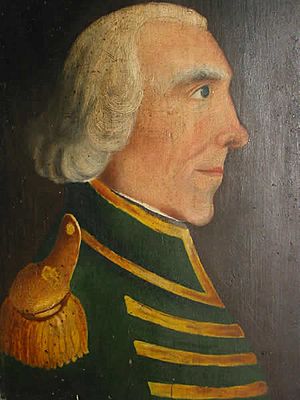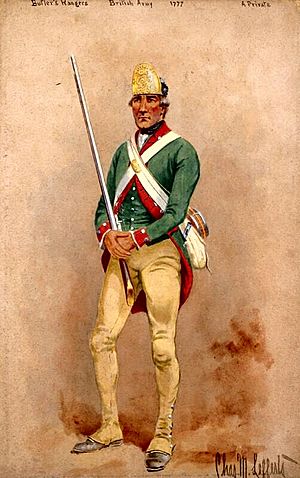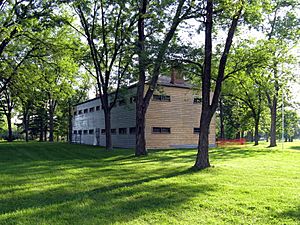John Butler (Ranger) facts for kids
Quick facts for kids
John Butler
|
|
|---|---|

Portrait of John Butler, date unknown
|
|
| Born | c. April 28, 1728 New London, Connecticut |
| Died | May 12, 1796 Newark, Upper Canada |
| Allegiance | Great Britain |
| Service/ |
British Army |
| Years of service | 1755–1784 |
| Rank | Lieutenant Colonel |
| Unit | Butler's Rangers |
| Battles/wars | French and Indian War |
John Butler (born around April 28, 1728 – died May 12, 1796) was an important military leader and landowner. He was born in America but served the British. During the American Revolutionary War, he was a strong Loyalist. This means he supported the British Crown, not the American rebels.
Butler led a special group of soldiers called Butler's Rangers. They fought along the borders of New York and Pennsylvania. John Butler grew up in New York. He learned several Iroquoian languages, which helped him work as an interpreter. This skill was very useful in the fur trade. It also helped him become friends with Mohawk and other Iroquois warriors. These warriors later became important allies for the British during the war.
During the Revolutionary War, Butler convinced the Seneca people to join a British plan in New York. After this, he got permission to create his "corps of rangers." This group worked closely with Britain's Native American allies. Butler's Rangers took part in raids in New York and Pennsylvania. These included the Cherry Valley Massacre and the Battle of Wyoming. After the war, Butler moved to Upper Canada (now Ontario). The British Crown gave him land for his service. He continued to be a leader there, helping to set up the Anglican Church and the Masonic Order.
Contents
John Butler's Early Life
John Butler was born in New London, Connecticut, in 1728. His parents were Walter Butler and Deborah Dennis. In 1742, his family moved to Fort Hunter in the Mohawk Valley, New York. This area was considered the frontier back then.
In 1752, John Butler married Catharine Bradt. She was of Dutch background. They had five children who grew up, though two others died when they were babies. John learned several languages spoken by Native American groups. This made him a good interpreter, especially for the fur trade.
Fighting in the French and Indian War
In 1755, John Butler became a captain in the British Indian Department. He fought in the French and Indian War alongside Sir William Johnson. This war was fought between Britain and France, with their Native American allies.
In 1758, Butler fought at Fort Ticonderoga and the Battle of Fort Frontenac. In 1759, he was second-in-command of the Native American forces at the Battle of Fort Niagara. Here, he helped defeat French soldiers. In 1760, he continued to serve in this role during the capture of Montreal.
Life Before the American Revolution
After the French and Indian War, Butler returned to New York. He bought a lot more land. His estate, called Butlersbury, grew to about 26,000 acres. It was near a major Mohawk village.
Butler became one of the richest landowners on the frontier. Only Sir William Johnson owned more land. Butler also worked for Johnson in the British Indian Department. In 1772, Butler became a judge in Tryon County, New York. He was also made a Lieutenant Colonel in the local militia. He was even elected to represent Tryon County in the New York assembly.
John Butler in the American Revolution
When the American Revolution began in 1775, John Butler became a Loyalist. This meant he stayed loyal to the British King. In May 1775, he traveled to Canada with other important figures. These included Joseph Brant, a famous Mohawk leader.
In November, Governor Guy Carleton sent Butler to Fort Niagara. His job was to keep the Native American groups neutral in the war. Butler's oldest son, Walter, served with him. However, his wife and other children were held by the American rebels.
In March 1776, Butler sent about 100 Native American allies to Montreal. They helped push the Americans out of Quebec. In May 1777, Butler was told to use Six Nations warriors in an attack on New York. He convinced about 350 Seneca warriors to join. He became second-in-command of the Native American forces.
Butler successfully planned an ambush of rebel soldiers and Oneida warriors at the Battle of Oriskany. Because of his success, he was promoted to Major. He was also allowed to create his own military group. This group became famous as Butler's Rangers. It started with eight companies of soldiers. He went back to Fort Niagara and finished recruiting the first company in December.
In July 1778, Butler led his rangers and Iroquois allies at the Battle of Wyoming. They defeated the American militia and captured Forty Fort. This battle was later called the "Wyoming Massacre." After the battle, homes and farms were burned. However, the people living there were not harmed.
Butler led his Rangers from his main base at Fort Niagara. In 1779, he was defeated at the Battle of Newtown. This was the main battle of the Sullivan Expedition, which was against the Iroquois. In the winter of 1780, he was promoted from Major to Lieutenant Colonel.
In 1780, Butler commanded four companies of Rangers. They took part in a large raid on the Schoharie and Mohawk Valleys. This raid ended with the Battle of Klock's Field on October 19, 1780. Later in the war, Butler's Rangers were spread out. They guarded frontier posts from Niagara all the way to Illinois.
After the War and His Death
When the American Revolution ended, John Butler was given land in the Niagara region. The British Crown gave it to him for his service. It also made up for his property in New York being taken away. He used this land for farming.
Butler became an important political leader in Upper Canada, which is now Ontario. He was a Deputy Superintendent for the Indian Department. He also became a Justice of the Peace and a local militia commander. He helped set up the Anglican Church and the Masonic Order in Ontario. Butler also worked with Sir John Johnson, 2nd Baronet to buy lands east of Toronto in 1787–1788.
John Butler died at his home in Niagara, Upper Canada, on May 12, 1796. He was 68 years old. His wife had passed away three years before him. Butler was survived by his three sons and one daughter. He is buried in the family burial ground in Niagara-on-the-Lake, Ontario.
John Butler's Legacy
- Col. John Butler School in Niagara-On-The-Lake is named after him. Many other places also carry his name. These include a hotel, a sports bar, and a street leading to his family burial ground.
- Butler's Barracks, built after the War of 1812, is also named for him. It is now a National Historic Site.
- In 2006, a bronze statue of Butler was placed at the Valiants Memorial in Ottawa. He is seen as a key person in the founding of British North America and Canada. He is honored alongside Mohawk leader Joseph Brant.
- In 2010, a statue was placed on a memorial stone at his old home site in Niagara-on-the-Lake, Ontario.




